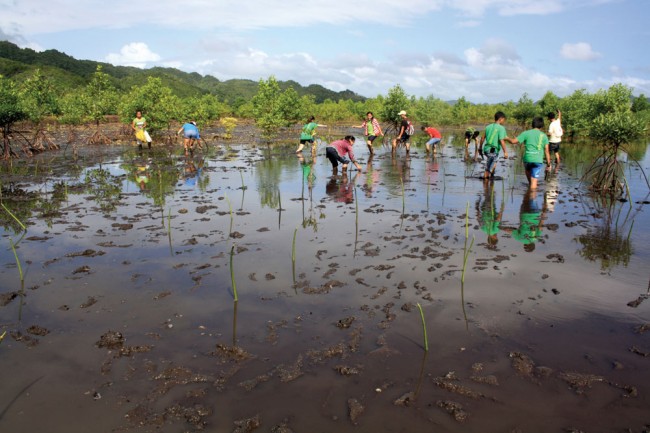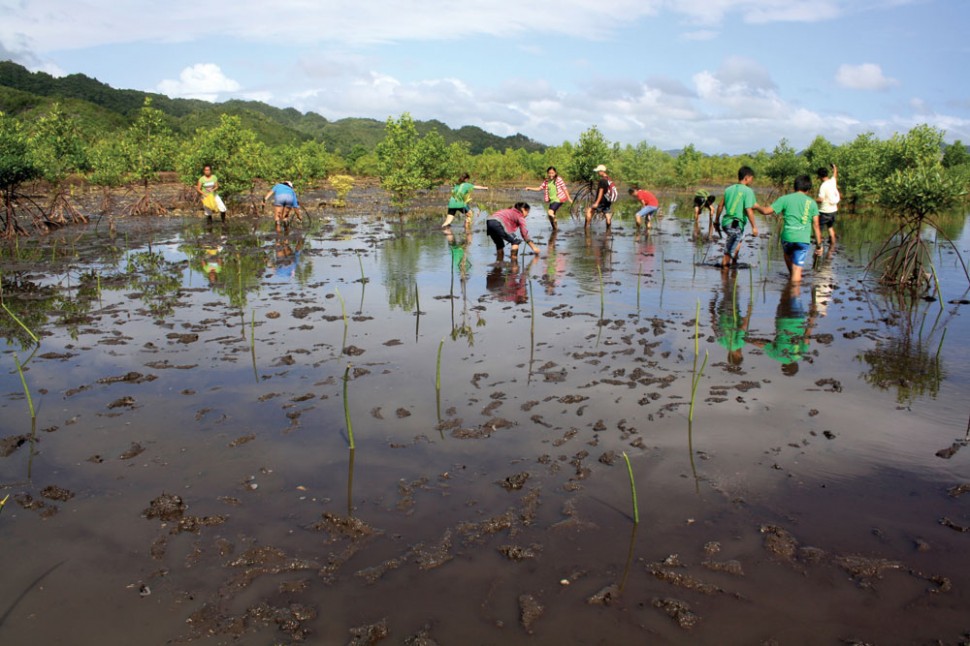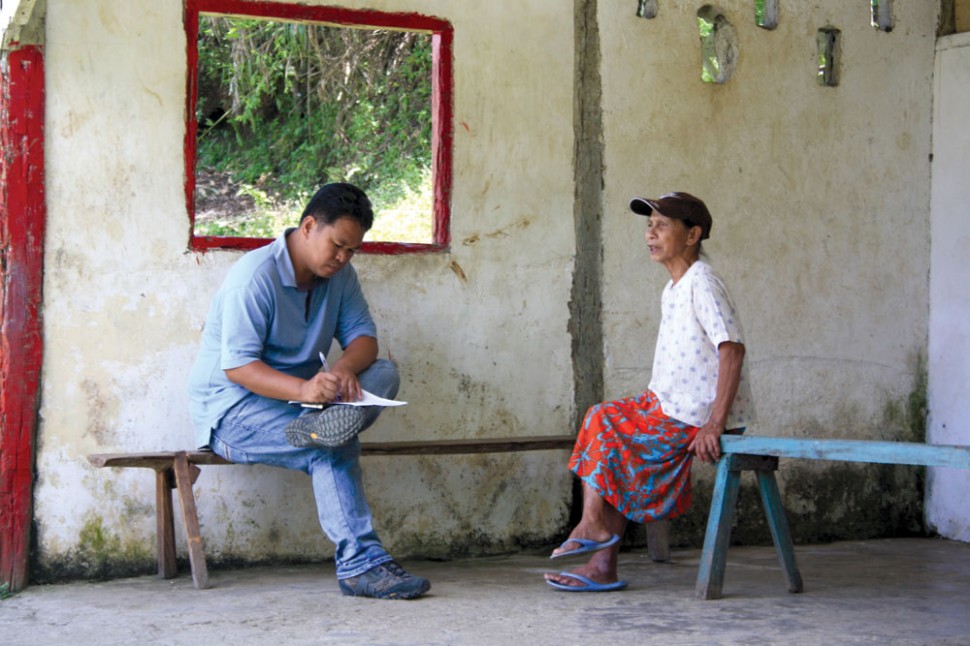
Photo Credit: Emily McGiffin
Modelling community-based forest stewardship
It’s early morning at the mouth of the Carood, a small river that drains the eastern end of the Philippine island of Bohol. In front of me, some 100 high-school students—trousers rolled up to their knees—are slogging barefoot through the brackish muck of an abandoned tilapia farm. Each student carries a dozen or so foot-long green sticks that, at intervals of a few metres, they stop to push into the ground. Stick by stick, amid laughter and occasional good-natured mud-slinging, they are replanting a mangrove forest on this stretch of tidal land.
The estuary is the lower extremity of a watershed that stretches across six municipalities and 20,000 hectares of rice paddies and woodlands. Most of the 11,000 households in the watershed eke out a meagre living through farming or petty trading. Under the increasing pressures of a growing, resource-dependent population, the landscape has long since begun to show signs of strain: deforested hillsides, waste-disposal issues, declining fisheries and, increasingly, water scarcity.
Serious efforts to address these issues began a decade ago with the establishment of the Carood Watershed Management Council. This grassroots organization brings together officers from each of the six municipalities, together with representatives from provincial and federal environment management bodies. In 2010, the Council became the 55th member of the International Model Forest Network, a global community of forest stewards that strives to balance the social and economic benefits that forested landscapes offer with environmental conservation.
A model of management practices
The Canadian Forest Service launched Canada’s Model Forest Program in 1991. The program was a response to what had become a dire need for a triple-bottom-line approach to forest management that would address social, environmental and economic needs in Canadian forest communities. Since then, the program has morphed into the Canadian Model Forest Network (CMFN), a non-profit organization with 15 model forests scattered across 10 provinces. These forests collectively cover more than 65 million hectares, encompass 125 communities and involve more than 1,100 stakeholders. During the sweeping changes that have transformed the Canadian forest sector over the past decade, the CMFN has played a key role in helping redevelop and diversify the economies of model forest communities and develop multi-sector, community-driven approaches to forest management.
In 1992, building on the project’s success, then-Prime Minister Brian Mulroney announced the establishment of the International Model Forest Network at the UN Earth Summit in Rio de Janeiro, inviting other countries to join the initiative. Twenty years later, the IMFN Secretariat, housed at the Natural Resources Canada office in Ottawa, now oversees model forests in 30 countries on five continents.
As their names imply, the goal of the Canadian and international model forest networks is to develop best practices of sustainable forest management that can serve as a model for other practitioners. The networks support community-driven approaches to ecosystem management, partnership-building among diverse stakeholders, and information sharing. They achieve this through an emphasis on innovations and by creating channels for sharing challenges, knowledge and lessons learned among network members.
Close to home
In 1992, Northwood Pulp and Timber Ltd. developed a partnership with the Canadian Model Forest Network to run the TFL 30, one of its tenure areas near Prince George, as a test area for landscape-level models. The IMFN emphasizes developing sustainable forest management practices on a landscape scale—but “landscape” is a relative term. In the Philippines, a 20,000-hectare land-base is substantial. Northern BC’s MacGregor Research Forest began with the 180,000-hectare research area. Over the course of its 15-year history, this land-base swelled to 7.7 million hectares, encompassing three major timber-supply areas and the towns of Burns Lake, Fort St John, Dawson Creek, MacKenzie and Chetwynd.
In 2007, the MacGregor Model Forest Association merged with the Integrated Resource Management Partnership of Northern BC to form Resources North, an association currently working to increase the economic diversity and resilience of resource-dependent communities. Rather than focusing strictly on forestry, Resources North is multi-sectoral, bringing forestry, mining, agriculture, oil-and-gas and other resource industries to the table to work and plan together. This integrated approach considers all resource values, rather than looking at a single sector at a time. The strategy helps avoid the compartmentalization that resource management is often prone to, considering instead the effects that different sectors have on one another.
“There are always multiple activities that need to be reconciled,” explains Melanie Karjala, general manager of Resources North, though she concedes that understanding the complex, compounding effects of various industries remains an area of scientific weakness.
“Everyone is trying to work out the nature of values,” she says. “Determining values of intrinsic characteristics like water, health and wildlife is still an area that needs a lot of work.”
She explains that current initiatives at Resources North are working to help address this knowledge gap and make information more readily available.
“Our role is to collaborate to help bring pieces together,” she says. “We act as a facilitator, creating opportunities and building capacity within communities.”
As a facilitating organization, Resources North currently focuses on engaging with communities to help them make informed choices about forest management, and expanding the knowledge base while creating new avenues to put information into the hands of communities.
Innovation
Like all environmental management practices—in Canada or elsewhere—the reforestation effort afoot in the Carood estuary takes time, energy and money—scarce resources in a region where many people struggle to get by. Yet efforts to rehabilitate mangrove forests have definite payoffs: they help maintain fisheries dependent on mangrove forests for spawning and rearing habitat; they act as formidable carbon sinks and, critically, mitigate the effects of typhoons that, in this part of the world, can be devastating for coastal communities. In upland areas, reforestation slows rainwater run-off, helping to filter and retain water and reducing the threat of landslides.
Storm protection, water filtration and carbon sequestration are all examples of services provided by healthy, functioning ecosystems. But as ecosystems worldwide increasingly suffer the effects of overpopulation and degradation, their abilities to provide these services has diminished. Usual methods of accounting consider the economic benefits that come with natural resource extraction, but fall short of measuring the full costs to communities when damaged natural systems no longer provide the ecological services people rely on.
With these issues in mind, the IMFN created its Ecological Goods and Services Strategic Initiative. This project promotes the importance and economics of ecological goods and services, looking for new ways to help integrate their management and conservation into the market economy.
The question of how to quantify the value of ecological services remains a thorny one. Critics in the environmental camp contend that reducing nature to sets of “services” that benefit humans undermines the strength of arguments to conserve nature for its own intrinsic value. Surely, they claim, we should accept that some things simply can’t be priced or traded away for any amount of money. Yet proponents of this emerging field point out that in the absence of an economic assessment, the default value of environmental goods and services tends to be zero. Too often, vital ecosystem functions like water purification simply aren’t part of the equation when it comes to natural resource accounting. Under these circumstances, argue many environmental economists, how is it possible to make good management decisions?
Bit by bit, the IMFN is working to shift the conversation. In the Carood watershed, they’ve begun by approaching residents with a simple question: Would you be willing to pay to support activities that will help preserve the environment and keep the water clean? Is this something that matters to you? Even in the face of poverty and uncertain incomes, the answer has been a resounding “Yes!”



